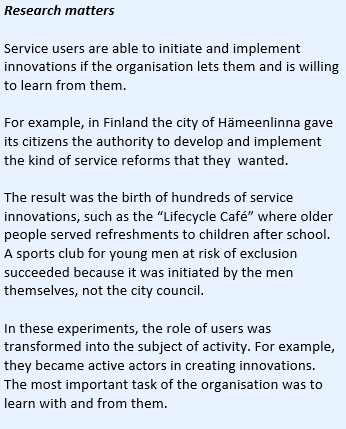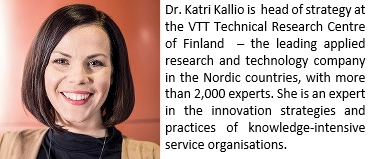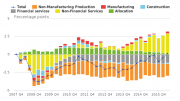You’ve set a strategy to take your business into the future. You know you must experiment to move things forward. Katri Kallio offers ways to do this successfully.
Europe and its many economic pillars are in transition. This is nothing new. A state of continuous business turmoil is the new normal for most industries.
Even within a sector some companies are under cost pressures and searching for cheap labour, while others face labour shortages due to exponential growth.
Ups and downs in business cycles are rapidly following each other, leaving nobody in a stable, successful state of business bliss. Technological development is advancing at breakneck speed, which both disrupts business models and creates opportunities for business reinvention.
Despite all the change programmes, business initiatives, public funding to boost innovation, corporate spending on R&D and marketing, still we hear that European companies are not growing fast enough. So, what is wrong?
Conventional wisdom says we need to run even faster. Economic and industrial transitions should be executed quickly and efficiently because change happens faster than ever before. Logically this implies that product and service development cycles must be sped up and shortened continuously.
Management and innovation literature, as well as prevailing business practices, emphasise that “failing fast” is a key ingredient for renewal. Failing fast means embracing continuously copious experiments – some will work, others will fail.
But are speed and failure the right answers for successful transition? And when you have failed fast, what happens next?
Instead of “failing fast”, organisations should invest in their ability to “learn fast”.
The emphasis on rapid experimentation and pivoting is a necessary precondition for innovation but it is not sufficient to ensure success.
 Trial and error, as such, will not create sustainable renewal. Envisioning different scenarios requires a sense of direction and of what might become a desired future which can be tested. We can call this a strategy, a hypothesis of the future. However, the most important prerequisite for organisations’ success is learning; reflecting thoroughly on what you have learned from the experiments.
Trial and error, as such, will not create sustainable renewal. Envisioning different scenarios requires a sense of direction and of what might become a desired future which can be tested. We can call this a strategy, a hypothesis of the future. However, the most important prerequisite for organisations’ success is learning; reflecting thoroughly on what you have learned from the experiments.
Instead of “failing fast”, organisations should invest in their ability to “learn fast”.
This includes, importantly, reflection both internally and in networks with different stakeholders.
What have you done in your organisation to invest in your learning ability? Are you learning fast? You can start reflecting on this by asking yourself and your organisation the following five questions. Without them your organisation’s knowledge might not turn into opportunities for innovation or into wisdom on how to renew your business strategically.
- How well do you appreciate the users? Innovation often comes from understanding the real goals and needs of users and from the ability to develop solutions that are best suited to satisfy those needs. Users’ needs are best understood through dialogue: by listening to users and by exploring their business environment. Are users and their ideas appreciated or even revered in your organisation?
- How do you learn consciously from users? Innovations often come up as new, generalisable solutions to everyday problems. Have you invested in involving users both in co-developing practical solutions and in more strategic situations where future direction is discussed?
- How do you encourage experimentation? Innovative solutions often arise from practical learning experiments. Both employees and users can be empowered to think and test novel solutions. This often requires multiple experiments.
- Have you created a space for common reflection? Various experiments generate a number of insights. Innovations call for the implementation of these insights because an idea without a practical application is not yet an innovation. This requires a space for common reflection – creating learning situations where experiences are critically analysed against the hypotheses both internally and with users.
- Have you created practices for learning? Responsibility for creating innovation lies with both management and employees. The emergence of innovations cannot depend on just extraordinary, random insights. Have you invested in building systematic learning practices where employees and management meet the users continuously and reflect properly on the experiments against the desired future?
For further information:
Katri Kallio (2015). Collaborative learning with users as an enabler of service innovation.





